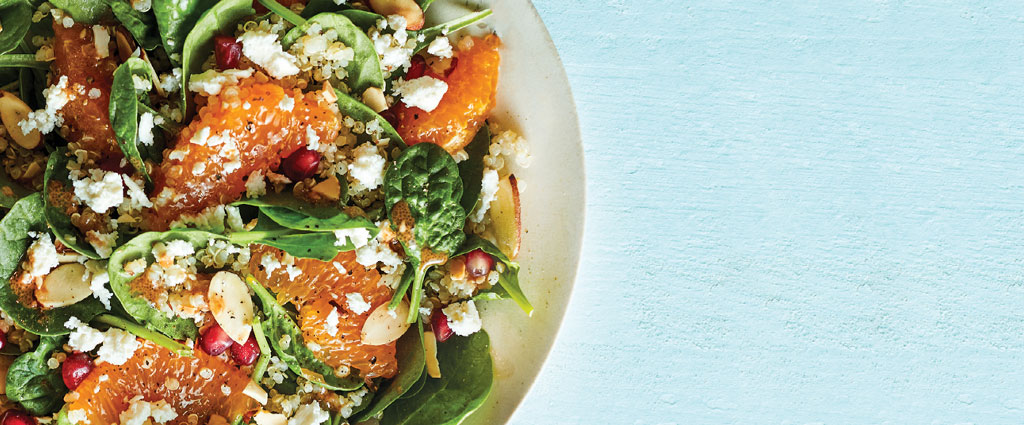Cooking with Spinach: Benefits and How-To
This dark, leafy green is full of flavor and nutrients.
Cooking with Spinach: Benefits and How-To
This dark, leafy green is full of flavor and nutrients.
What is it?
Spinach is one of the most versatile leafy greens. It can be eaten raw or cooked and can be found fresh, frozen or canned in the grocery store. Spinach is categorized into three main groups: savoy, semi-savoy and smooth-leafed spinach. It can be planted in spring, fall and even winter, depending on the spinach type and climate you live in.
RECIPES USING SPINACH
What are its potential health benefits?
Eating a diet rich in fruits and vegetables may reduce the risk of some diseases like heart disease and some cancers. Spinach is a good source of many vitamins and minerals like iron, vitamin A, vitamin C, vitamin K, vitamin B-6, potassium, riboflavin and magnesium. Spinach is also naturally fat-free, low-sodium, cholesterol-free, sugar-free and low-calorie.
Three Quick Tips to Help with Iron Deficiency
Your body needs this essential mineral to carry oxygen through your blood.
How do you cook with it?
Spinach has a light, sweet, herby taste but can become bitter if overcooked. As mentioned above, spinach is one of the most versatile leafy greens and is a delicious addition to smoothies, pasta, casseroles, dips, soups and sandwiches. It is a great way to boost the nutrients in any dish, from breakfast to lunch or dinner. Spinach can be eaten raw, sautéed, roasted, boiled, baked or stewed. For spinach recipe inspiration, check out the recipe section at Kroger.
A few tips and tricks:
- Drain and dry spinach leaves as well as you can before cooking them. Why? A bunch of fresh spinach gets dramatically smaller when cooked. Although you might think it won’t fit in a pan, the water in it soon evaporates and shrinks it to a fraction of its former volume.
- Don’t have fresh spinach? Use frozen. Just bear in mind that for every 2 pounds of fresh spinach, you’ll need less than half the weight in frozen spinach.
- Use spinach within a few days for best flavor and nutrition.
What are its potential health benefits?
Eating a diet rich in fruits and vegetables may reduce the risk of some diseases like heart disease and some cancers. Spinach is a good source of many vitamins and minerals like iron, vitamin A, vitamin C, vitamin K, vitamin B-6, potassium, riboflavin and magnesium. Spinach is also naturally fat-free, low-sodium, cholesterol-free, sugar-free and low-calorie.
RECIPES USING TURMERIC
What are its potential health benefits?
Eating a diet rich in fruits and vegetables may reduce the risk of some diseases like heart disease and some cancers. Spinach is a good source of many vitamins and minerals like iron, vitamin A, vitamin C, vitamin K, vitamin B-6, potassium, riboflavin and magnesium. Spinach is also naturally fat-free, low-sodium, cholesterol-free, sugar-free and low calorie.
Three Quick Tips to Help with Iron Deficiency
Your body needs this essential mineral to carry oxygen through your blood.
How do you cook with it?
Spinach has a light, sweet, herby taste but can become bitter if overcooked. As mentioned above, spinach is one of the most versatile leafy greens and is a delicious addition to smoothies, pasta, casseroles, dips, soups and sandwiches. It is a great way to boost the nutrients in any dish, from breakfast to lunch or dinner. Spinach can be eaten raw, sautéed, roasted, boiled, baked or stewed. For spinach recipe inspiration, check out the recipe section at Kroger.
A few tips and tricks:
- Drain and dry spinach leaves as well as you can before cooking them. Why? A bunch of fresh spinach gets dramatically smaller when cooked. Although you might think it won’t fit in a pan, the water in it soon evaporates and shrinks it to a fraction of its former volume.
- Don’t have fresh spinach? Use frozen. Just bear in mind that for every 2 pounds of fresh spinach, you’ll need less than half the weight in frozen spinach.
- Use spinach within a few days for best flavor and nutrition.
ABOUT THE AUTHOR
Kristen Keen (MBA, RDN, LD) believes having a strong understanding of nutrition is the key to feeling great, and having a good relationship with food should center around the power of self-love. For Kristen, this means balancing a bowl of her childhood favorite SpaghettiOs® with a bowl of oranges and pistachios... and a good baseball game!
Did you know? You can meet virtually with a Kroger dietitian to help you achieve your personal wellness nutrition goals. Learn more about Telenutrition.
ABOUT THE AUTHOR
Kristen Keen (MBA, RDN, LD) believes having a strong understanding of nutrition is the key to feeling great, and having a good relationship with food should center around the power of self-love. For Kristen, this means balancing a bowl of her childhood favorite SpaghettiOs® with a bowl of oranges and pistachios... and a good baseball game!
Did you know? You can meet virtually with a Kroger dietitian to help you achieve your personal wellness nutrition goals. Learn more about Telenutrition.







Share this Post